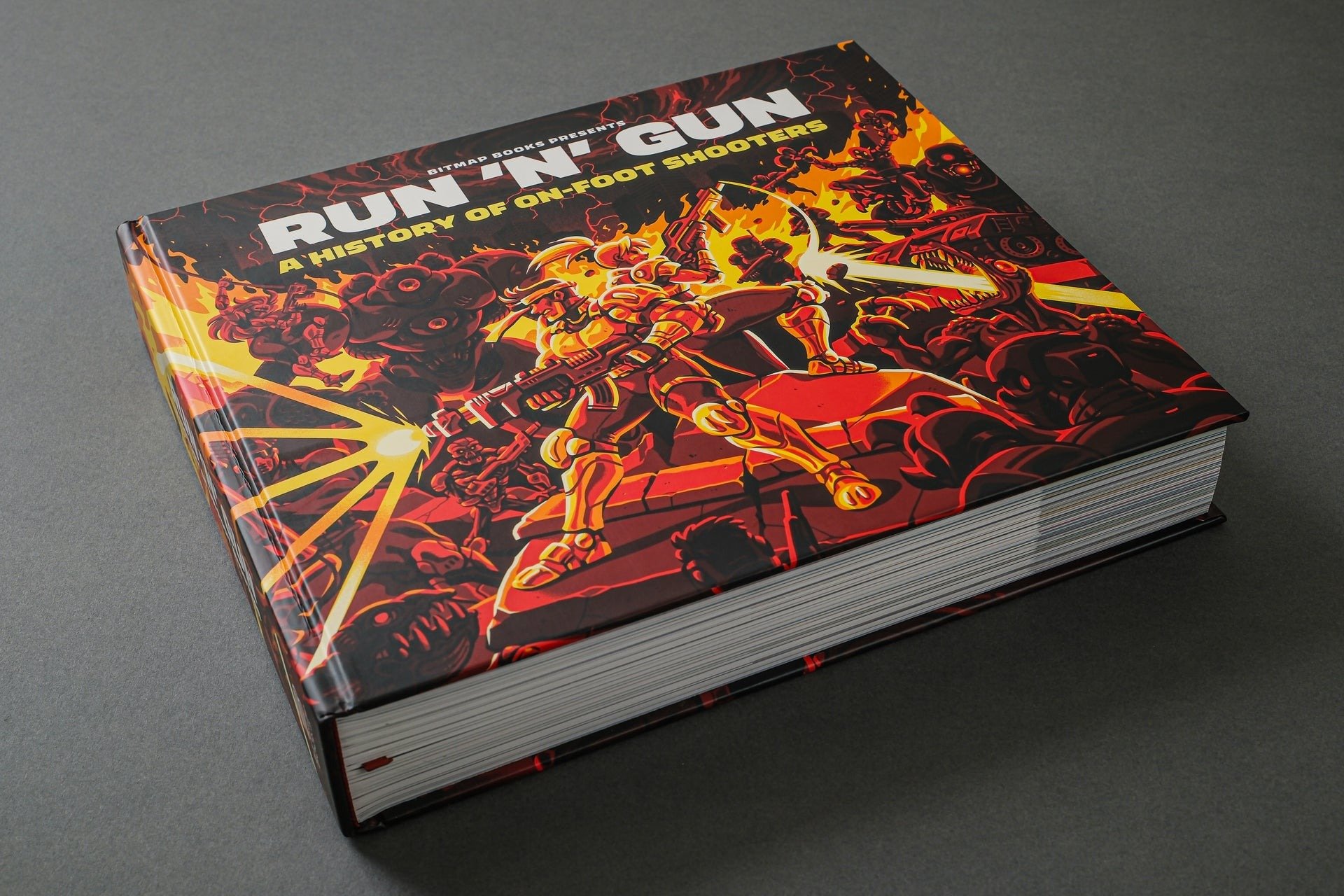No stone is left unturned in this exhaustive history of an exhausting genre
Having read Dave Cook’s previous tome, Go Straight: The Ultimate Guide to Side-Scrolling Beat-‘Em-Ups – a book which sits precariously on the shelf above my bed, threatening me with a crushing death every single night – I was extremely motivated to check out this new bit of business for three main reasons.
1) Go Straight was rather good.
2) The run ‘n’ gun genre of computer-based video-presented activity is among(st) my favourites.
3) Every additional Bitmap Books joint on the aforementioned shelf hastens the inevitability of having my head smashed completely in by the corner of a 500-page hardback, and in turn welcoming the sweet release of death.
So they were onto a winner here from the start, especially given that the run ‘n’ gun lineage does not have a competing book from Hardcore Gaming 101, as Go Straight went toe-to-toe with HG101 Presents: The Guide to Beat-‘Em-Ups, which covered much of the same ground albeit in a different, more port-focused way. Thankfully, it seems an accord has been reached, as HG101’s Kurt Kalata is credited with “additional writing” in Run ‘N’ Gun: A History of On-Foot Shooters, along with the omnipresent Chris Scullion and a chap apparently named Sega Lord X. The poor fellow. Regardless, the book is covering ground yet to be immortalised in pagination, though now that I think about it, HG101 did do a Contra book back in 2017.
The scope here, though, is much grander. Beginning with an attempt to nail down the elements of what constitutes a run ‘n’ gun game, the book dives in with 1980s Wizard of Wor and runs (and guns) all the way up to 2023’s Prison City. The eagle-eyed will have already noticed that the understood definition of “run ‘n’ gun” has been stretched, but that’s something you’ll need to get over quickly. Rather than debate genre semantics, it’s best to just get stuck into this patently enormous collection of games within which it is inarguable that you will either run or gun.

While some games only receive half a page to themselves, it’d be difficult to say they were short-changed; the writing deftly packs in information and opinion, though even the larger articles retain a sort of games magazine-ish feel that contrasts with many Bitmap Books’ other releases; it comes over as more of a conversational tone, like someone is describing these games to you excitedly rather than exhaustively recounting their history or taking any kind of academic approach. This is far from a bad thing, being a style of writing that suits the whole run ‘n’ gun thing in all its scrappiness. It makes the whole thing very cheerful, though there are some oddities here and there in sentence structure and some repetition in the text – early on, I noticed that two subsequent early entries end with the text “give it a try”, which is a perfectly acceptable suggestion but struck me as the sort of thing a copy editor would spank my bottom over. Then again, sometimes I feel like my copy editor seems to contrive reasons to spank my bottom.
Really, I’m just trying to get anything negative I have to say about this book out of the way – and I have. Everything else about this volume is excellent, all the way down to its screenshot captions that manage to pack in more information and detail about each game where space is something of a premium. Entries do range in size from half-pages (as mentioned) to full pages, two-page spreads and even longer for the more significant titles such as Mega Man. Many of the games are accompanied by additional features that get into the nitty-gritty of specific titles in a pleasing way, adding to the magazine feel by evoking the classic “boxout” of yore; a look at the various colour-coded enemies seen in Namco’s Rolling Thunder, a guide to the locations featured in Robocop Versus The Terminator or an extensive overview of the different mutations offered in Nuclear Throne. Which, in turn, highlights another joy of this book – contemporary indie games are treated with the same respect and afforded the same number of column inches as the stone-cold classics of the genre.

Reaching beyond those classics is what elevates this book so much for me. It’d be one thing to have yet another set of printed words telling you how good Gunstar Heroes is (and it, of course, is), but lesser-known offerings such as the Amiga’s terrific Walker, Gaelco’s Biomechanical Toy or licensed efforts such as True Lies or the excellent Demolition Man get their moment in the sun, too – games that are barely documented anywhere by anyone. Seeing PC-98 and Amiga titles alongside the expected PlayStation offerings pleaseth The Gipp. Nothing is given short shrift, not even the absurd DS title Barnyard Blast: Swine of the Night.
While I don’t agree with all of the authors’ points of view (Gunstar Super Heroes a “worthy successor”? You’re ‘avin’ a larf, aintcha?), this is an extensive collection of games that doesn’t discriminate based on reputation or obscurity, and as a result I’ve come away from it with yet another laundry list of stuff to check out. This is, of course, the greatest danger of the Bitmap Books ouevre… you read ’em and then you’ve got to play everything. Same deal with Go Straight, same with From Ants to Zombies. Another good read full of good words and good screenshots that help iilustrate concepts and mechanics raised by said words. It would be churlish to ask for more, but I will anyway. Can I have some more, please?





